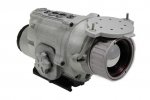When I was at the 2013 Shot Show checking out the new gear at the L3 booth, I got to handle the new L-3 Thermal AN/PAS-13G(V)1.
http://www.insighttechnology.com/l3-products/light-weapon-thermal-sight-lwts
It looked like a very nice unit with a 640X480 17 micron VOx core that had automatic NUNC as well as internal reticules enabling it to be used as a stand alone thermal scope.
This instrument looked like an excellent clip-on when mated up to an ACOG and I have been trying to find out more information regarding it's use and pricing.
The good folks at LDI that I spoke to told me that it has been only recently been released for commercial civilian use, as previously it had been only Mil & LE.
Their review of it here on video from the Shot Show also specifically mentions this:
http://www.adsinc.com/blog/products/l3-warrior-systems-insight-eotech-2013-shot-show-video-coverage/
My question for all you Mil and LE folks that have used this unit is how did you like it compared to the FLIR T50/T-60/T-70 thermal units?
It seems as though it would be a tough competitor for the upgraded FLIR T-65 with the 640X480 core that I also got to handle at the FLIR booth at the Shot Show....
I am waiting for the upgraded FLIR T-65 to be released to the public and this L3 looks like it would be in close competition with the FLIR.....
http://www.insighttechnology.com/l3-products/light-weapon-thermal-sight-lwts
It looked like a very nice unit with a 640X480 17 micron VOx core that had automatic NUNC as well as internal reticules enabling it to be used as a stand alone thermal scope.
This instrument looked like an excellent clip-on when mated up to an ACOG and I have been trying to find out more information regarding it's use and pricing.
The good folks at LDI that I spoke to told me that it has been only recently been released for commercial civilian use, as previously it had been only Mil & LE.
Their review of it here on video from the Shot Show also specifically mentions this:
http://www.adsinc.com/blog/products/l3-warrior-systems-insight-eotech-2013-shot-show-video-coverage/
My question for all you Mil and LE folks that have used this unit is how did you like it compared to the FLIR T50/T-60/T-70 thermal units?
It seems as though it would be a tough competitor for the upgraded FLIR T-65 with the 640X480 core that I also got to handle at the FLIR booth at the Shot Show....
I am waiting for the upgraded FLIR T-65 to be released to the public and this L3 looks like it would be in close competition with the FLIR.....









